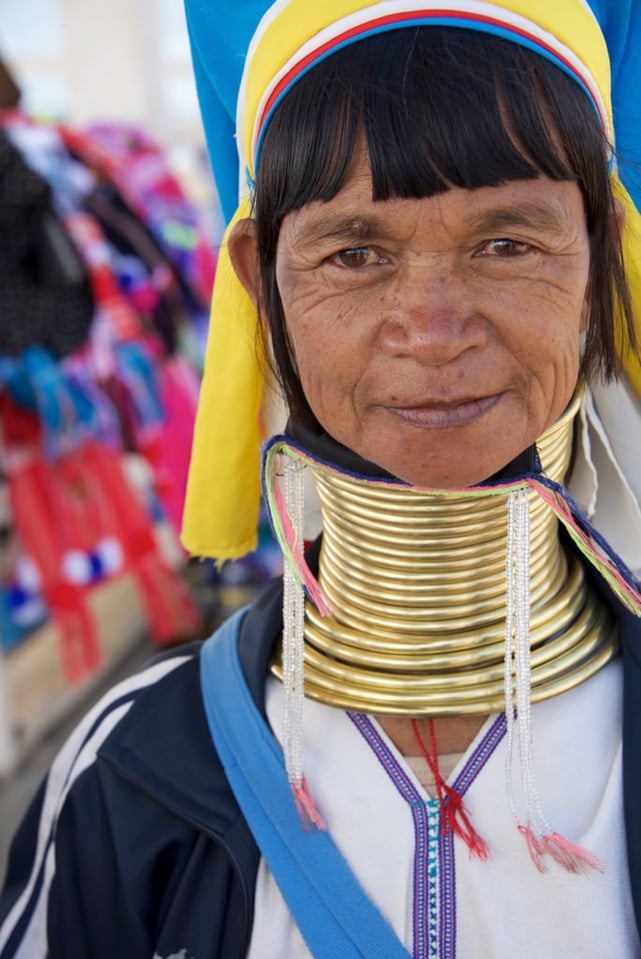Two ethical issues might obstruct your visit to Kayah State in Myanmar to visit the “long-necked ladies” of the Padaung Tribe. First, you might not wish to visit a country whose army is committing genocide against its Rohingya minority, never mind that you are at the far end of the country from that sadness. But, your tourist dollars are supporting the guides, restaurant owners and their staff, and all the other people who rely on them for their livelihood. And, your absence isn’t making much of a difference to the army.
Second, you might wonder about gawking at these ladies, whose necks were elongated by the brass coils that continue to support their heads. Would you go to a freak show and stare at deformed individuals? This still troubles me after a day of wandering through the Padaung villages, taking pictures, watching them weave, listening to them sing, handing them huge bars of soap as tokens of appreciation and buying the traditional scarves they weave. I am minimally assuaged by Pascal Khoo Thwee’s autobiography, which also contains a trove of historical information.
Mr. Thwe, born in 1967, is Padaung and a graduate of Cambridge University. His book, From the Land of the Green Ghosts, is well-written and fascinating. Drawing on other sources, he talks about the Padaung ladies taken to Europe in the 1880s to tour with a “freak show.” He says they were delighted to be paid not to work and their only complaints were the strange food and having to wear shoes.
Mr. Min, my guide, also told me not to worry, they know what they are doing. Better to have me come visit them at their home village than for them to have to travel to an artificial village set up as a tourist attraction either in Thailand or near the Chinese border, as some have done. Also, tourists give them the chance to sell their handicrafts and earn some of the money they need to bring themselves modernity. Besides, he explained, they are proud of their custom.
Thin solace for many I’m sure. Nonetheless, there I was in Loikaw (sounds like “troika”), capital of Kayah State, on my way to see the ladies, my rationale being to get there before Starbucks and Ronald McDonald. I see, in the near future, a sort of reverse Potemkin Village: “Quick, hide the cell phones, here come the tourists!”.
I didn’t know when I arranged the trip, but electricity came to the Padaung a year earlier, so they were now on the way from the bronze age to the 21st century, with all the changes that cell phones and satellite dishes bring.
And time is running. There are about 8,000 Padaung. Only about 400 women continue to wear the neck rings. Since the process must start when girls are five and many of those 400 are still young, the custom is not in imminent danger but the villages are already changing.
Italian missionaries have been here since the 1880s. Half the Padaung are Catholic, the other half Buddhist, both halves with generous sprinklings of the animism and spirit beliefs that preceded “modern” religion and shouldn’t be a surprise given their proximity to and dependence on nature.
They are farmers and hunters. They work hard but had a balance with nature that the modern world upends.
Mr. Thwe explains that the custom of neck coils began about 500 years ago, actually intended to protect the women from tiger attacks. The women also wear similar coils on their wrists and shins, since tigers apparently usually went for those parts as well as for the neck. The tigers are long gone from the neighborhood, their habitat of course a victim of human encroachment, but the custom continues.
The women are friendly and don’t mind having their pictures taken as they sit on their porches and weave or go about other activities of daily living. This isn’t unusual in Myanmar – most everywhere I traveled people were delighted to have their pictures taken – and often encouraged me. They were delighted to see their images on the small screen of my camera.
Many Padaung villages are clustered about a 40 minute drive from Loika, along a single dusty main street. They are still quiet, except for an occasional motor bike and music trailing from a cell phone. On the porches of many homes – no longer of wood and bamboo construction but now cinder block – the ladies offer hand-woven scarves for sale and will pose for pictures at their traditional looms. Some will play a guitar and sing a traditional song. As yet, they do not seek “donations,” but no doubt appreciate your purchase of their cotton scarves. The cotton is local but the chemical dyes now come from India.
There is clinic now and a small school. There are satellite dishes and occasionally I spot someone with a cell phone. Tomorrow comes quickly.
Getting There: Daily morning flights to Loika on Myanmar Airways from Yangon, or a 5 hour drive from Heho Airport (Inle). Then, 30 minutes by car.
Where to Stay: There are Spartan but clean hotels in Loikaw.
This guest post was contributed by Mark Handelman.













It’s ethnic cleansing and one of the world’s poorest country Bangla Desh gets to deal with a million refugees.
Gee I bet you’ll would go to Bavaria in the 40’s to photograph peasants in their costumes and ignore any mention of Auschwitz you have no morals
This is a rude comment. The photographer was clear about his intentions and his discomfort with encroachment. Did you read the article or just look at the pictures and comment?